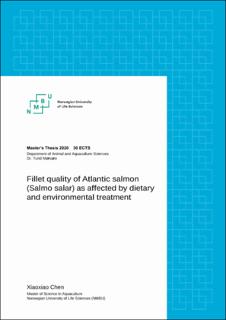| dc.description.abstract | Fillet quality of Atlantic salmon (Salmo salar L) is crucial for both salmon producers and consumers. There are endogenous and exogenous factors that affect fillet quality. This thesis mainly focuses on exogenous factors: diet and environment, studied in a two-year-long experimental trail.
Dietary high protein-to-lipid (P/L) ratio (Test diet) and low protein-to-lipid (P/L) ratio diet (Control diet) were fed to Atlantic salmon reared in sea net pens (Flemma) to investigate dietary influence on biometric traits and fillet quality. Effect of rearing environments was studied in salmon reared in commercial sized sea net pens located on the Norwegian west coast (Flemma) or in small research tanks on land (Sunndalsøra). All fish were reared in seawater and the feed used in the environmental study was the Control diet.
Major fillet quality parameters analyzed include fillet gaping, fillet color, myocommata and myomere’s area, width and color (L*, a* and b* values), drip loss and fillet texture. Fillet analyses were determined post-rigor (fresh fillets). Additionally, drip loss and texture were analyzed after frozen storage (thawing at 4ºC and 20ºC).
Salmon reared in sea net pens (Flemma) have significantly higher body weight, body length, fillet yield, fillet color, brighter and wider myocommata, improved firmness, slimmer body shape (lower condition factor, CF), as well as lower fillet gaping and less drip loss. Feeding salmon high P/L diet significantly increased fillet color score and myomere’s area, but significantly decreased myocommata’s lightness (L* value). Frozen storage resulted in decreased firmness and increased drip loss, with a significantly higher drip loss from fillets thawed at 4ºC compared with 20 ºC. The effect of frozen storage and thawing conditions showed the same pattern for the dietary groups and rearing environment.
To summarize, fillet quality of farmed Atlantic salmon is improved by feeding high protein-to-lipid (P/L) diet and rearing in large sea net pens. Effects of rearing environment were more pronounced than effects of dietary treatment. | en_US |

